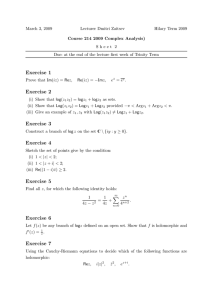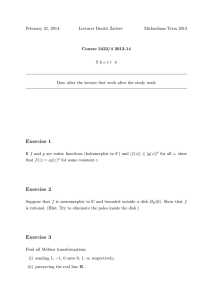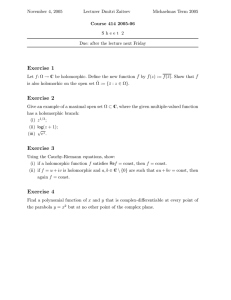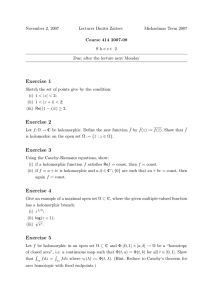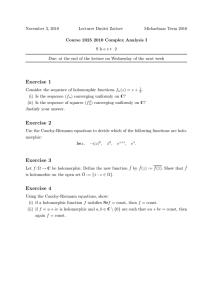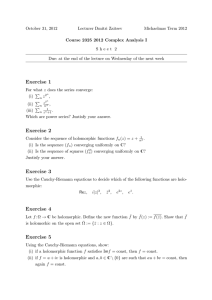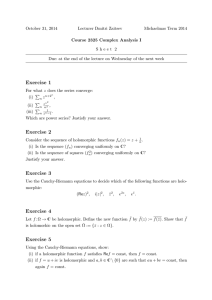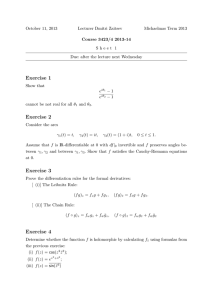Document 10417397
advertisement
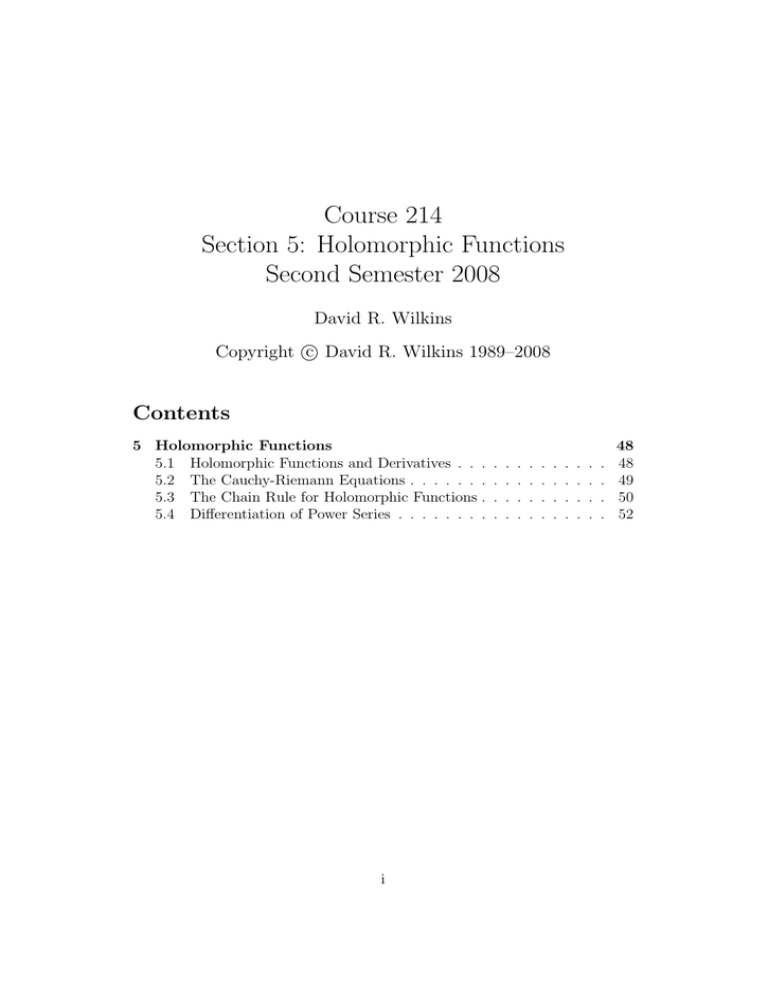
Course 214
Section 5: Holomorphic Functions
Second Semester 2008
David R. Wilkins
c David R. Wilkins 1989–2008
Copyright Contents
5 Holomorphic Functions
5.1 Holomorphic Functions and Derivatives . . .
5.2 The Cauchy-Riemann Equations . . . . . . .
5.3 The Chain Rule for Holomorphic Functions .
5.4 Differentiation of Power Series . . . . . . . .
i
.
.
.
.
.
.
.
.
.
.
.
.
.
.
.
.
.
.
.
.
.
.
.
.
.
.
.
.
.
.
.
.
.
.
.
.
.
.
.
.
48
48
49
50
52
5
5.1
Holomorphic Functions
Holomorphic Functions and Derivatives
Definition A function f : D → C defined on an open set D in the complex
plane is said to be holomorphic on D if the limit
f (z + h) − f (z)
h→0
h
f 0 (z) = lim
is defined for all z ∈ D. The value of this limit is denoted by f 0 (z), or by
df (z)
, and is referred to as the derivative of the function f at z.
dz
Note that if f : D → C is a holomorphic function defined on an open set C
in the complex plane then f is continuous on D. For let z ∈ D. Then
f (z + h) − f (z)
lim f (z + h) = lim f (z) + h ×
h→0
h→0
h
f (z + h) − f (z)
= f (z) + lim h
lim
h→0
h→0
h
= f (z),
and thus the function f is continuous at z, as required.
Lemma 5.1 A function f : D → C, defined on an open set D in the complex
plane, is holomorphic on D if and only if, given any complex number w
belonging to D, and given any positive real number ε, there exists some real
positive number δ such that |f (z) − f (w) − (z − w)f 0 (w)| ≤ ε|z − w| whenever
|z − w| < δ.
Proof The function f has a well-defined derivative f 0 (w) at a point w of D
if and only if
f (w + h) − f (w)
f (z) − f (w)
= lim
.
z→w
h→0
h
z−w
f 0 (w) = lim
This limit exists if and only if, given any positive real number ε, there exists
some positive real number δ such that
f (z) − f (w) − (z − w)f 0 (w) ≤ε
z−w
whenever 0 < |z −w| < δ. The required result follows directly on rearranging
the above inequality.
48
Proposition 5.2 Let f : D → C and g: D → C be holomorphic functions
defined over an open set D in the complex plane. Then the sum f + g,
difference f − g and product f · g of the functions f and g are holomorphic,
where (f + g)(z) = f (z) + g(z), (f − g)(z) = f (z) − g(z) and (f · g)(z) =
f (z)g(z) for all z ∈ D. Moreover (f + g)0 (z) = f 0 (z) + g 0 (z), (f − g)0 (z) =
f 0 (z) − g 0 (z) and (f · g)0 (z) = f 0 (z)g(z) + f (z)g 0 (z) for all z ∈ D.
Proof The results for f + g and f − g follow easily from the fact that the
limit of a sum or difference of two complex-valued functions is the sum or
difference of the limits of those functions (Proposition 1.11). The limit of
a product of complex-valued functions is the product of the limits of those
functions, and therefore
f (z + h)g(z + h) − f (z)g(z)
h→0
h
(f (z + h) − f (z)
= lim
g(z + h)
h→0
h
g(z + h) − g(z)
+ lim f (z)
h→0
h
0
0
= f (z)g(z) + f (z)g (z),
(f · g)0 (z) = lim
as required.
5.2
The Cauchy-Riemann Equations
Let f : D → C be a holomorphic function defined over an open set D in the
complex plane, and let D̃ denote the open set in R2 defined by
D̃ = {(x, y) ∈ R2 : x + iy ∈ D}.
Then the holomorphic function f on D determines differentiable real-valued
functions u and v on D̃ such that f (x + iy) = u(x, y) + iv(x, y) for all
(x, y) ∈ D̃. Now if g is a function of a complex variable, defined in the
neighbourhood of zero, then limh→0 g(h), if it exists, has the same value
whether h tends to 0 along the real axis or along the imaginary axis. It
follows that if lim g(h) exists then
h→0
lim g(h) = lim g(t) = lim g(it),
h→0
t→0
t→0
where t tends to zero through real values only. On applying this principle to
the holomorphic function f , we find that the limit
f (z + h) − f (z)
h→0
h
f 0 (z) = lim
49
u(x + h, y) + iv(x + h, y) − u(x, y) − iv(x, y)
h→0
h
∂v(x, y)
∂u(x, y)
+i
=
∂x
∂x
= lim
and also
f (z + h) − f (z)
h→0
h
u(x, y + h) + iv(x, y + h) − u(x, y) − iv(x, y)
= lim
h→0
ih
∂v(x, y)
∂u(x, y)
=
−i
∂y
∂y
f 0 (z) = lim
It follows that the functions u and v must satisfy the partial differential
equations
∂v
∂v
∂u
∂u
=
,
=− .
∂x
∂y
∂x
∂y
These equations are referred to as the Cauchy-Riemann equations. Thus to
each holomorphic function f there corresponds a pair of differentiable realvalued functions u and v, defined over an open subset of R2 and satisfying the
above system of partial differential equations. The converse is true (provided
that the partial derivatives of the functions u and v are continuous).
5.3
The Chain Rule for Holomorphic Functions
Proposition 5.3 Let f : D → C and g: E → C be holomorphic functions
defined over open sets D and E in the complex plane. Suppose that f (D) ⊂
E. Then the composition function g ◦ f : D → C is a holomorphic function
on D, and (g ◦ f )0 (z) = g 0 (f (z))f 0 (z) for all z ∈ D.
Proof Let z0 be a point of D and let w0 = f (z0 ). Then
g(f (z)) − g(f (z0 ))
f (z) − f (z0 )
= G(f (z))
,
z − z0
z − z0
for all z ∈ D satisfying z 6= z0 , where
g(w) − g(w0 )
G(w) =
0 w − w0
g (w0 )
if w 6= w0 ; .
if w = w0 ,
Now lim G(w) = G(w0 ), and therefore the function G is continuous at w0
w→w0
(Lemma 1.12). It follows that the composition function G ◦ f : D → C is
50
continuous at at z0 (Lemma 1.14), and therefore lim G((f (z)) = G(f (z0 )) =
z→z0
0
G(w0 ) = g (f (z0 )). It follows from standard properties of limits of complexvalued functions (Proposition 1.11) that the limit defining the derivative
(g ◦ f )0 (z0 ) of g ◦ f at z0 exists, and
g(f (z)) − g(f (z0 ))
lim
z→z0
z − z0
f (z) − f (z0 )
=
lim G(f (z))
lim
z→z0
z→z0
z − z0
0
0
= g (f (z0 ))f (z0 ),
(g ◦ f )0 (z0 ) =
as required.
Let γ: (a, b) → C be a complex-valued function defined on an open interval
(a, b). Then there are real-valued functions α and β defined on (a, b) such
that γ(t) = α(t) + iβ(t). for all t ∈ (a, b). We say that the function γ is
differentiable on (a, b) if the functions α and β are differentiable, in which
case we define
γ 0 (t) =
dα(t)
dβ(t)
γ(t + h) − γ(t)
dγ(t)
=
+i
= lim
.
h→0
dt
dt
dt
h
Lemma 5.4 Let f : D → C be a holomorphic function defined over a subset D of C and let γ: [a, b] → D be a continuously differentiable path in D.
Then (f ◦ γ)0 (t) = f 0 (γ(t))γ 0 (t) for all t ∈ [a, b].
Proof The method of proof is the same at that used to prove Proposition 5.3.
Given t0 ∈ (a, b) let z0 = γ(t0 ), and let
f (z) − f (z0 )
if z 6= z0 ; .
F (z) =
z
−
z
0
0
f (z0 ))
if z = z0 ,
for all z ∈ D. Then the function F is continuous at z0 , and therefore
f (γ(t0 + h)) − f (γ(t0 ))
h→0
h
γ(t0 + h) − γ(t0 )
= lim F (γ(t0 + h))
h→0
h
0
0
= F (γ(t0 ))γ (t0 ) = f (γ(t0 ))γ 0 (t0 ),
(f ◦ γ)0 (t0 ) = lim
as required.
51
Lemma 5.5 Let f : D → C be a holomorphic function defined over a subset D of C and let γ: [a, b] → D be a piecewise continuously differentiable
path in D. Then
Z
f 0 (z) dz = f (γ(b)) − f (γ(a))
γ
Proof First suppose that the path γ: [a, b] → D is continuously differentiable. It follows from Lemma 5.4 and the definition of the path integral
that
Z
Z b
Z b
0
0
0
f (z) dz =
f (γ(t))γ (t) dt =
(f ◦ γ)0 (t) dt = f (γ(b)) − f (γ(a)).
γ
a
a
Now let γ be a piecewise continuously differentiable path. Then there exist
real numbers s0 , s1 , . . . , sm satisfying a = s0 < s1 < · · · < sm = b such that
the restriction γi : [sj−1 , sj ] → D of γ to the interval [sj−1 , sj ] is continuously
differentiable for j = 1, 2, . . . , n. Then
Z
m Z
m
X
X
0
0
f (z) dz =
f (z) dz =
(f (γ(sj )) − f (γ(sj−1 )))
γ
j=1
γj
j=1
= f (γ(b)) − f (γ(a)),
as required.
5.4
Differentiation of Power Series
Theorem 5.6 Let
+∞
P
an z n be a power series which converges around z = 0,
n=0
let R be a positive real number that does not exceed the radius of convergence
of this power series, let
D = {z ∈ C : |z| < R}
and let f (z) =
and f 0 (z) =
+∞
P
an z n for all z ∈ D. Then f : D → C is holomorphic on D,
n=0
+∞
P
nan z n−1 .
n=1
Proof Let R0 be a positive real number satisfying R0 < R, and let z and w
be complex numbers satisfying |z| ≤ R0 and |w| ≤ R0 . Now
!
n−1
X
z n − wn = (z − w)
z j wn−1−j .
j=0
52
It follows that
n−1
X
j n−1−j n
n
z w
|z − w | = |z − w| ≤ nR0n−1 |z − w|,
j=0
and
n−1
X
(z j − wj )wn−1−j |z n − wn − n(z − w)wn−1 | = (z − w)
j=0
≤ |z − w|
n−1
X
|z j − wj |R0n−1−j
j=0
≤ |z − w|2 R0n−2
1
|z
2
≤
2
− w|
n−1
X
j
j=0
n−2
R0 n(n
− 1).
Choose some real number R1 satisfying R0 < R1 < R, and let ρ = R0 /R1 .
Then there exists some positive real number M such that |an |R1n ≤ M for
all non-negative integers n. But then
|nan z n−1 | ≤ nM R1−1 ρn−1
and
|an (z n − wn − n(z − w)wn−1 )| ≤ 12 M R1−2 n(n − 1)ρn−2 |z − w|2
for all non-negative integers n. Now ρ < 1, and therefore the infinite series
+∞
+∞
P n−1
P
nρ
and
n(n − 1)ρn−2 are convergent. Indeed the convergence of
n=1
n=2
these series may be verified by straightforward applications of the Ratio Test;
moreover the first converges to (1 − ρ)−2 and the second converges to 2(1 −
ρ)−3 . An immediate application of the Comparison Test shows that the
+∞
P
infinite series
nan z n−1 converges to some complex number g(z) whenever
n=1
|z| ≤ R0 . Moreover
+∞
X
n
n
n−1 |f (z) − f (w) − (z − w)g(w)| = an (z − w − n(z − w)w )
n=0
≤
+∞
X
|an (z n − wn − n(z − w)wn−1 )|
n=0
≤ C|z − w|2
53
whenever |z| ≤ R0 and |w| ≤ R0 where
C=
1
M R1−2
2
+∞
X
n(n − 1)ρn−2 = M R1−2 (1 − ρ)−3 .
n=2
It follows from this that if |w| < R0 then
f (z) − f (w)
≤ C|z − w|,
−
g(w)
z−w
and therefore
f (w + h) − f (w)
f (z) − f (w)
= lim
= g(w),
z→w
h→0
h
z−w
lim
It follows from this that the derivative of the function f at w exists, and its
value is g(w). Thus the function f is holomorphic throughout {z ∈ C : |z| ≤
+∞
P
R0 }, and f 0 (z) = g(z) =
nan z n−1 .
n=1
Finally we note that given z ∈ D, we can choose R0 so that |z| < R0 < R.
It follows that the function f is holomorphic throughout D as required.
Let f : D → C be a continuous function defined over an open set D in the
d
complex plane. If there exist functions f (1) , f (2) , . . . , f (m) such that f (z) =
dz
d (j−1)
(j)
(1)
f
(z) = f (z) for values of j satisfying 1 < j ≤ m then
f (z) and
dz
we say that the function f is m times differentiable on D, and we refer to
the function f (m) as the mth derivative of the function f .
Corollary 5.7 Let
+∞
P
an z n be a power series which converges around z = 0,
n=0
let R be a positive real number that does not exceed the radius of convergence
of this power series, let
D = {z ∈ C : |z| < R}
and let f (z) =
+∞
P
an z n for all z ∈ D. Then f : D → C is m times differen-
n=0
tiable for all positive integers m, and the mth derivative of f on D is given
by the formula
f (m) (z) =
+∞
+∞
X
X
n!
dm
n
(a
z
)
=
an z n−m .
n
m
dz
(n
−
m)!
n=m
n=m
54
Remark Corollary 5.7 shows that if a function may be represented as the
sum of a power series, then it may be differentiated any number of times.
Moreover the derivatives of the function may be calculated by differentiating
the power series term by term. It is a remarkable fact that any holomorphic
function may be represented in the neighbourhood of a complex number
belonging to its domain as the sum of a power series. We shall prove this
result using the theory of path integrals of holomorphic functions developed
by Cauchy in the early decades of the nineteenth century. Given this fact,
it follows from Corollary 5.7 that any holomorphic function defined over an
open subset of the complex plane has derivatives of all orders.
Example Let exp: C → C be the exponential function, defined by exp(z) =
+∞ n
X
z
. This function is holomorphic throughout the entire complex plane,
n!
n=0
and
X
+∞
+∞ n
+∞
X
X
d zn
z
z n−1
d
(exp(z)) =
=
= exp(z).
=
dz
dz n!
(n − 1)! n=0 n!
n=0
n=1
Example The power series
∞
X
zn
converges for all complex numbers z satn
isfing |z| < 1. Let f (z) be the sum of this power series for all complex
numbers z satisfying |z| < 1. Then f is a holomorphic function on the open
unit disk about 0, and
n=1
0
f (z) =
+∞
X
z n−1 =
n=1
1
,
1−z
Let D1,1 = {z ∈ C : |z − 1| < 1}, and let L: D1,1 → C be the holomorphic
function defined by L(z) = −f (1 − z) for all z ∈ D1,1 . Then L(1) = 0 and
L0 (z) = z −1 for all z ∈ D1,1 .
Now the principal branch of the logarithm function satisfies exp(log(z)) =
z for all z ∈ D1,1 . On differentiating this identity we find that
1=
d
d
d
(exp(log(z))) = exp(log(z)) (log(z)) = z (log(z)) .
dz
dz
dz
Thus log0 (z) = z −1 for all z ∈ D1,1 . Thus the function that sends z ∈ D1,1
to L(z) − log(z) has zero derivative throughout D1,1 . A straightforward
application of Lemma 5.5 shows that this function must be constant along
all continuously differentiable paths in D1,1 , and therefore must be constant
55
throughout D1,1 . But L(1) = 0 = log 1. We conclude therefore that L(z) =
log(z) for all z ∈ D1,1 . Thus
∞
X
zn
n=1
n
= − log(1 − z)
for all complex numbers z satisfying |z| < 1.
56
